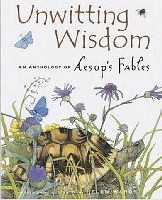 According to the thesaurus, a fable is an allegory, a fairy tale, a legend, a tale, or even a “whopper!” Reading fables can teach children descriptive vocabulary and inference as they listen to a seemingly simple story with a moral or lesson to be learned. Abstract thinking is required to make a generalization about the story and its meaning.
According to the thesaurus, a fable is an allegory, a fairy tale, a legend, a tale, or even a “whopper!” Reading fables can teach children descriptive vocabulary and inference as they listen to a seemingly simple story with a moral or lesson to be learned. Abstract thinking is required to make a generalization about the story and its meaning.
I wanted to share a beautiful collection of Aesop’s Fables called Unwitting Wisdom, An Anthology of Aesop’s Fables, retold and illustrated by Helen Ward. The award winning illustrator takes your breath away with her sweeping, expressive drawings introducing each fable. They stand alone as opportunities to describe, predict or make up a story yourself. Ward re-tells 12 of the fables using rich vocabulary, challenging to upper elementary aged students. Describing the fox who was camouflaged as a sheep to get closer to his prey, “In the evening he moved with the contented, murmuring flock to the close comfort of the sheepfold.”
Ward closes each fable with the moral written short and sweet–“Harm seek, harm find.”
Read the fable and pause to ask questions checking for understanding. At the end, encourage the child to think abstractly and tell you the lesson that is learned. Help the child formulate her answer to finally be concise and precise. Many times they will give a quick re-tell of the story rather than summarize the lesson learned.



